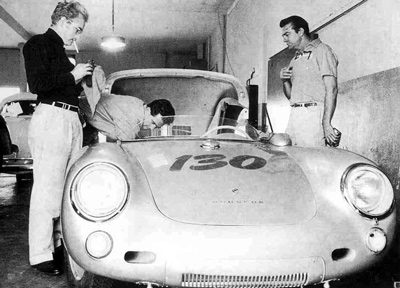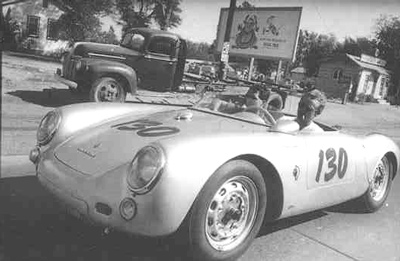
|
December 5th, 2007
A Great book for the Holidays
James Dean: From Passion for Speed to Immortality
By Philippe Defechereux
Published by
Dalton
Watson.
132 Pages, 121 photographs, 300mm x 230mm
ISBN 1-85443-215-X
Price US $30.00
There are over twenty five books written about James Dean, (American actor 1931-1955), who starred in three Hollywood movies, entered five automobile races, and died at the age of twenty four on a two lane road on his way to a race in Salinas, CA. Philippe Defechereux�s book, �James Dean, From Passion for Speed to Immortality� is the latest of the lot and for us car nuts, no doubt the best. Defechereux literally resurrects Dean, provides a great deal of new material and photos, and tells us why the Porsche-owning Dean wanted to race a Grand Prix Maserati 250 F in Europe.
What inspired Defechereux and dozens of other authors to write a book about James Dean is a very good question that defies a conclusive answer. A single simple sentence is enough to sum up his short life and would have fit on his tombstone. Should we chalk it up to American pop culture and our impulsive need to both sanctify and demonize those who inhabit the insatiable world of the mass media? Or does Dean really deserve all the hoopla?

Dean lovingly washes his Porsche Speedster. His enthusiasm for cars and racing was genuine. Photo courtesy Seita Ohnishi, Sandy Roth Collection.
|
Dean�s acting talents were considerable, but it was his attitude and rebellious nature which captured the mood of a generation. While his fame rivaled that of even his sulking peers Marlon Brando and Elvis Presley, director Elia Kazan, who discovered both Brando and Dean, did not reckon him to be a major talent. This may have been a bit of sour grapes on Kazan�s part, and to be fair, Michael T. Lynch, author of �American Sports Car Racing in the 1950s�, (and VeloceToday contributor) found a more substantial character in Dean. �He may have been a rebel, but with a cause, not without one,� said Lynch. �I view Dean as a very organized guy who applied his talent in a calculating way to achieve what he wanted. In high school, he won the Indiana section of the National Forensic League contest and went on to finish 6th nationally. He won drama and athletic awards when he graduated . He attended the Actor's Studio, where people like Brando had studied, and had good roles on both Broadway and TV before hitting the jackpot with �East of Eden�.
�He was the same way with his racing. Admittedly, he was put to the head of the line at von Neumann's to get a Speedster, which gave him an advantage in his class. Nonetheless, he practiced diligently and took instruction from others so that he was in a position to win the first race he competed in.�
Lynch also wrote the introduction to Defechereux's book, and places Dean into the fabric of the Southern California sports car scene. It was here where Dean got his feet wet with his Porsche Speedster. Lynch lights up the colorful and competitive nature of CalCub events, noting that �In Dean�s first four races�he won his class three times and finished second once.� Though the Dean race results--class wins at regional events--may at first sound lightweight, they must be taken in context with the nature of the competition.
A Passion Neglected
James Dean was born at the right place and the right time with the right face and 24 years later, on September 30th 1955, Dean was in the wrong place at exactly the wrong time. With a thin but very well done volume, Defechereux sketches the Dean between the two places. Defechereux, born in Belgium, first read about Dean in 1993. �I was interested in Dean for two main reasons: I am a rebel myself and I identified strongly with him. Then I�m passionate about racing, did some myself, and I loved his passion for it, for which he died.� Obsessed by this American icon, he then read the other twenty-some books on Dean.

Dean, on the left, looks on as his mechanic, Rolf W�therich prepares the new Spyder for the Salinas event. Photo courtesy Seita Ohnishi, Sandy Roth Collection.
|
Defechereux found that none made much mention of Dean�s interest in cars and when they did, they often got it wrong. �I read an outstanding biography where every Hollywood detail was right but where there were also many car racing errors. I identified his passion for speed not as that of a reckless youth, but that of a serious professional racing driver in-the-making. No one else had ever documented that.�
The dearth of accurate information may be due to the comparative total lack of interest in foreign cars during the mid 1950s. Most Americans had never seen a Porsche and certainly didn�t even know how to pronounce the name. In 1958, puzzled about the proper pronunciation of the Austrian name, a friend of the editor�s wrote to Ferry Porsche and asked. Weeks later, a thin envelope arrived via airmail, the factory stating that Porsche is pronounced Portia, as in �Portia Faces Life�, a soap opera which aired on the CBS Television network in 1945 and 1955. American culture, if lacking in snob status, was no doubt popular, even in the land of Goethe and Beethoven.
Dean and Italy
Defechereux's European background enabled him to look at Dean and his times with a different perspective. �Since Europeans are much more passionate about sports car racing than Americans, and I attended my first car races at Spa-Francorchamps when I was six, I definitely viewed Dean and the whole CalClub scene with a different perspective. I felt his passion.�
Although Dean�s two sports cars were both Porsches, Defechereux thinks that eventually Dean would have driven and raced Italian cars. Dean once said to newspaperman Gus Vignolle that his greatest ambition was to own a Maserati for Grand Prix racing in Europe. Defechereux puts Dean into the scene at Ernie McAfee�s garage on Sunset Boulevard, a veritable hotbed of all the latest Italian machinery, and catches Dean trying on the von Neumann Ferrari for size. The path to success at the time was to graduate to larger displacement cars, and it was obvious that Dean would soon be behind the wheel of a two or three liter Ferrari, a necessary item for class and overall wins in the era.
For those who may not be as attuned to American Pop Culture as many of our readers, note that there are two James Deans. One is the subject of this review, and is usually referred to as �James�. Jimmy Dean, only three years older than James, was as successful country music singer and businessman who also became famous for his Jimmy Dean Sausages. Jimmy Dean is retired and lives between Williamsburg VA and Richmond,on the James River.
At the same time, Dean�s affair with the Italian born actress Pier Angeli got into his blood going. He was in love, but Angeli�s Catholic mother urged her beautiful daughter to marry Italian American singer Vic Damone. Defechereux, with ample evidence, muses that Dean thought that succeeding on the race tracks of Europe would win the favor of Pier�s mother. And of course Dean would do this while driving a Maserati or Ferrari.

Dean and his mechanic on their way to a date with immortality. This was, fittingly, the last photo taken of James Dean before his death. Photo courtesy Seita Ohnishi, Sandy Roth Collection.
|
The many photographs from the era--a score never published elsewhere---are both professional and relevant to the story. Our favorite is Dean talking to a very young Ursula Andress. Another is a photo of Dean with his young nephew, on the floor putting together a scale model Jaguar. Scattered about alongside are the sports car magazines Dean bought and studied. Defechereux managed to obtain permission to publish the photos of Dean taken by Sandy Roth, who documented Dean�s last day. If one loves cars and must own one book about James Dean, this is the one.
The Death of Dean
We can only speculate on what might have been had Dean lived a normal lifespan. We do know, however, that his early demise ensured his immortality. Since his death occurred behind the wheel of a very fast, exotic and expensive race car on the way to a road race in Salinas, it was of interest to the media and of interest to car enthusiasts. Over the years, many stories were published about the accident, the crushed Porsche Spyder in which he died mysteriously disappeared (and remains a mystery), but no one got all the facts and visual evidence together like Defechereux, including most of Roth�s accident scene images. Admittedly this plays to the sensational side but we also have to admit that there is a sensation seeking side to our personalities. It is likely that you, too, may read the book from the last chapter first.
Defechereux thinks that there are no true European counterparts to Dean. �Jean-Louis Trintignant, son of the French racing ace and star of the movie �A Man and a Woman,� where he races a Ford GT-40, did not die young and was not really passionate about racing. There is nobody else in Europe comparable to Dean. That�s why he is still a major icon there. Dean got more TV documentaries in Europe for the 50th anniversary in 2005 than in America!�
Though it has now been over 52 years since James Dean arrived and suddenly departed, his presence still looms large in our culture. The late David Halberstam, in his book "The Fifties", wrote, "Brando might have had a bigger career and done more distinquished work, but Dean's legend was greater..."
Defechereux has produced a legendary book on a legendary figure, and a great present for the holidays for any car enthusiast. Click on Dalton
Watson. You won't be disappointed.
|

|



